Analysis Procedure for Earthquake Resistant Structures
von: Farzad Hejazi, Keyhan Karimzadeh
Springer-Verlag, 2018
ISBN: 9789811088391
, 536 Seiten
Format: PDF
Kopierschutz: Wasserzeichen
Preis: 128,39 EUR
eBook anfordern 
Mehr zum Inhalt

Analysis Procedure for Earthquake Resistant Structures
This book presents an analysis procedure for structures that are exposed to the lateral loads such as earthquake and wind. It includes the process for calculating and distributing the effective load into structural elements, as well as for calculating the displacements for different types of structures, e.g. reinforced concrete and steel framed structures. The book provides civil engineers with clear guidelines on how to perform seismic analysis for various building systems, and how to distribute the lateral load to the structural components.
This book consists of 4 chapters: The first chapter offers an introduction, while Chapter 2 discusses moment resistance frame. The final two chapters explore shear wall frames and brace frames respectively. Each chapter follows the same structure, explaining step by step all the necessary algorithms, equations and procedures for calculating 1) loads, 2) the centre of mass, 3) stiffness of structures, 4) centre of stiffness, 5) lateral loading, 6) the distribution of lateral loads, and 7) the lateral displacement.
Demonstrating the implementation of real building analysis, the book provides architectural drawings and structural plans at the beginning of each chapter.
Farzad Hejazi is an associate professor at University Putra Malaysia. He is also innovation coordinator for the Faculty of Engineering and senior lecturer at the department of Civil Engineering at the same university. Further, he is the research coordinator at the Structural Unit and a member of the management committee of the UPM Housing Research Center. He received his PhD in Structural Engineering from University Putra Malaysia in 2011 and was postdoctoral fellow there until 2012.
In addition he teaches postgraduate courses for master's and PhD students in structural engineering fields such as the finite element method, structural dynamics, advanced solid mechanics, advanced structural analysis and earthquake resistance structure. His main research interests include the development of earthquake-energy dissipation systems using advanced modern technologies; and the numerical simulation, experimental testing and optimization of the performance of structural controllers using smart and intelligent system in order to diminish the effects of earthquake on structure and to guarantee safety of buildings in natural disasters.









